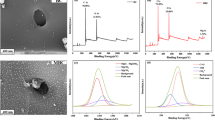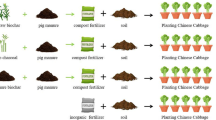Abstract
With the growing concerns about antibiotic resistance, it is more and more important to prevent the environmental pollution caused by antibiotic fermentation residues. In this study, composted erythromycin fermentation residue (EFR) with the mixture of cattle manure and maize straw at ratios of 0:10 (CK), 1:10 (T1), and 3:10 (T2) explores the effects on physicochemical characteristics, mobile genetic elements (MGEs), and antibiotic resistance genes (ARGs). Results reflected that the addition of EFR reduced the carbon/nitrogen ratio of each compost and improved the piles’ temperature, which promoted the composting process. However, the contents of Na+, SO42−, and erythromycin were also significantly increased. After 30 days of composting, the degradation rates of erythromycin in CK, T1, and T2 were 72.7%, 20.3%, and 37.1%, respectively. Meanwhile, the total positive rates for 26 detected ARGs in T1 and T2 were 65.4%, whereas that of CK was only 23.1%. Further analysis revealed that ARGs responsible for ribosomal protection, such as ermF, ermT, and erm(35), dominated the composts of T1 and T2, and most were correlated with IS613, electrical conductivity (EC), nitrogen, and Zn2+. Above all, adding EFR helps to improve the nutritional value of composts, but the risks in soil salinization and ARG enrichment caused by high EC and erythromycin content should be further investigated and eliminated.






Similar content being viewed by others
Data availability
The datasets used and/or analyzed during the current study are available from the corresponding author on reasonable request.
References
Asano R, Sasaki T, Nakai Y (2007) Isolation and characterization of sulfur oxidizing bacteria from cattle manure compost. Anim Sci J 78:330–333. https://doi.org/10.1111/j.1740-0929.2007.00443.x
Azim K, Soudi B, Boukhari S, Perissol C, Roussos S, Thami Alami I (2018) Composting parameters and compost quality: a literature review. Org Agric 8:141–158. https://doi.org/10.1007/s13165-017-0180-z
Blázquez E, Gabriel D, Baeza JA, Guisasola A (2016) Treatment of high-strength sulfate wastewater using an autotrophic biocathode in view of elemental sulfur recovery. Water Res 105:395–405. https://doi.org/10.1016/j.watres.2016.09.014
Cardelli R, Saviozzi A, Cipolli S, Riffaldi R (2008) Compost and cattle manure as sources of inorganic sulphur to soil. Arch Agron Soil Sci 54:139–147. https://doi.org/10.1080/03650340701793595
Chu L, Chen D, Wang J, Yang Z, Shen Y (2019) Degradation of antibiotics and antibiotic resistance genes in erythromycin fermentation residues using radiation coupled with peroxymonosulfate oxidation. Waste Manag 96:190–197. https://doi.org/10.1016/j.wasman.2019.07.031
Feng H, Tang M, Han Z, Luan X, Ma C, Yang M, Li J, Zhang Y (2023) Simultaneous determination of erythromycin and its transformation products in treated erythromycin fermentation residue and amended soil. Chemosphere 313 137414 https://doi.org/10.1016/j.chemosphere.2022.137414
Fernandes P, Martens E, Pereira D (2017) Nature nurtures the design of new semi-synthetic macrolide antibiotics. J Antibiot (tokyo) 70:527–533. https://doi.org/10.1038/ja.2016.137
Gomes C, Martínez-Puchol S, Palma N, Horna G, Ruiz-Roldán L, Pons MJ, Ruiz J (2017) Macrolide resistance mechanisms in Enterobacteriaceae: focus on azithromycin. Crit Rev Microbiol 43:1–30. https://doi.org/10.3109/1040841X.2015.1136261
Goulas A, Belhadi D, Descamps A, Andremont A, Benoit P, Courtois S, Dagot C, Grall N, Makowski D, Nazaret S, Nélieu S, Patureau D, Petit F, Roose-Amsaleg C, Vittecoq M, Livoreil B, Laouénan C (2020) How effective are strategies to control the dissemination of antibiotic resistance in the environment? A systematic review. Environ Evid 9:1–32. https://doi.org/10.1186/s13750-020-0187-x
Harindintwali JD, Zhou J, Yu X (2020) Lignocellulosic crop residue composting by cellulolytic nitrogen-fixing bacteria: a novel tool for environmental sustainability. Sci Total Environ 715 136912 https://doi.org/10.1016/j.scitotenv.2020.136912
Hoekstra NJ, Bosker T, Lantinga EA (2002) Effects of cattle dung from farms with different feeding strategies on germination and initial root growth of cress (Lepidium sativum L.). Agric Ecosyst Environ 93:189–196. https://doi.org/10.1016/S0167-8809(01)00348-6
Khan MA, Campbell WF, Dudley LM, Jurinak JJ (1995) Interactive effects of sodium chloride sodium sulfate calcium sulfate and calcium chloride on snapbean growth photosynthesis and ion uptake. J Plant Nutr 18:889–900. https://doi.org/10.1080/01904169509364946
Li XZ, Plésiat P, Nikaido H (2015) The challenge of efflux-mediated antibiotic resistance in Gram-negative bacteria. Clin Microbiol Rev 28:337–418. https://doi.org/10.1128/CMR.00117-14
Liao H, Zhao Q, Cui P, Chen Z, Yu Z, Geisen S, Friman VP, Zhou S (2019) Efficient reduction of antibiotic residues and associated resistance genes in tylosin antibiotic fermentation waste using hyperthermophilic composting. Environ Int 133 105203 https://doi.org/10.1016/j.envint.2019.105203
Luo Y, Liang J, Zeng G, Chen M, Mo D, Li G, Zhang D (2018) Seed germination test for toxicity evaluation of compost: its roles problems and prospects. Waste Manag 71:109–114. https://doi.org/10.1016/j.wasman.2017.09.023
Meng X, Liu B, Xi C, Luo X, Yuan X, Wang X, Zhu W, Wang H, Cui Z (2018) Effect of pig manure on the chemical composition and microbial diversity during co-composting with spent mushroom substrate and rice husks. Bioresour Technol 251:22–30. https://doi.org/10.1016/j.biortech.2017.09.077
Partridge SR, Kwong SM, Firth N, Jensen SO (2018) Mobile genetic elements associated with antimicrobial resistance. Clin Microbiol Rev 31:1–61. https://doi.org/10.1128/CMR.00088-17
Pu C, Yu Y, Diao J, Gong X, Li J, Sun Y (2019) Exploring the persistence and spreading of antibiotic resistance from manure to biocompost soils and vegetables. Sci Total Environ 688:262–269. https://doi.org/10.1016/j.scitotenv.2019.06.081
Qian X, Sun W, Gu J, Wang XJ, Zhang YJ, Duan ML, Li HC, Zhang RR (2016) Reducing antibiotic resistance genes integrons and pathogens in dairy manure by continuous thermophilic composting. Bioresour Technol 220:425–432. https://doi.org/10.1016/j.biortech.2016.08.101
Qian X, Gu J, Sun W, Wang XJ, Su JQ, Stedfeld R (2018) Diversity abundance and persistence of antibiotic resistance genes in various types of animal manure following industrial composting. J Hazard Mater 344:716–722. https://doi.org/10.1016/j.jhazmat.2017.11.020
Ren J, Xu C, Li C, Deng L, Dong L, Wang C, Huhe T, Niu D (2022a) Effects of adding thermally treated penicillin mycelial dreg on the lignocellulose degradation, fungal diversity, and fertilizer efficiency of compost. Waste Biomass Valori. https://doi.org/10.1007/s12649-022-01985-6
Ren J, Deng L, Li C, Dong L, Li Z, Huhetaoli Zhang J, Niu D (2021a) Effects of added thermally treated penicillin fermentation residues on the quality and safety of composts. J Environ Manag 283 111984 https://doi.org/10.1016/j.jenvman.2021.111984
Ren J, Deng L, Niu D, Wang Z, Fan B, Huhetaoli Li L, Zhang J, Li C (2021b) Isolation and identification of a novel erythromycin-degrading fungus Curvularia sp., RJJ-5 and its degradation pathway. FEMS Microbiol Lett 368 fnaa215 https://doi.org/10.1093/femsle/fnaa215
Ren J, Deng L, Li C, Li Z, Dong L, Zhao J, Zhang J, Niu D (2022b) Evolution of antibiotic resistance genes and bacterial community during erythromycin fermentation residue composting. Environ Pollut 309 119746 https://doi.org/10.1016/j.envpol.2022.119746
Safianowicz K, Bell TL, Kertesz MA (2018) Bacterial population dynamics in recycled mushroom compost leachate. Appl Microbiol Biotechnol 102:5335–5342. https://doi.org/10.1007/s00253-018-9007-4
Sánchez ÓJ, Ospina DA, Montoya S (2017) Compost supplementation with nutrients and microorganisms in composting process. Waste Manag 69:136–153. https://doi.org/10.1016/j.wasman.2017.08.012
Sánchez-Monedero MA, Roig A, Cegarra J, Bernal MP, Noguera P, Abad M, Antón A (2004) Composts as media constituents for vegetable transplant production. Compost Sci Util 12:161–168. https://doi.org/10.1080/1065657X.2004.10702175
Schafhauser BH, Kristofco LA, de Oliveira CMR, Brooks BW (2018) Global review and analysis of erythromycin in the environment: occurrence bioaccumulation and antibiotic resistance hazards. Environ Pollut 238:440–451. https://doi.org/10.1016/j.envpol.2018.03.052
Shen Y, Chu L, Zhuan R, Xiang X, Sun H, Wang J (2019) Degradation of antibiotics and antibiotic resistance genes in fermentation residues by ionizing radiation: a new insight into a sustainable management of antibiotic fermentative residuals. J Environ Manage 232:171–178. https://doi.org/10.1016/j.jenvman.2018.11.050
Siguier P, Gourbeyre E, Chandler M (2014) Bacterial insertion sequences: their genomic impact and diversity. FEMS Microbiol Rev 38:865–891. https://doi.org/10.1111/1574-6976.12067
Sun X, Zhao J, Wang Q, Ren X, Li R, Kumar Awasthi M, Zhang Z (2020) Behaviors and related mechanisms of Zn resistance and antibiotic resistance genes during co-composting of erythromycin manufacturing wastes and pig manure. Bioresour Technol 318 124048 https://doi.org/10.1016/j.biortech.2020.124048
Wu N, Xie S, Zeng M, Xu X, Li Y, Liu X, Wang X (2020) Impacts of pile temperature on antibiotic resistance, metal resistance and microbial community during swine manure composting. Sci Total Environ 744 140920 https://doi.org/10.1016/j.scitotenv.2020.140920
Xing L, Yu H, Qi J, Jiang P, Sun B, Cui J, Ou C, Chang W, Hu Q (2015) ErmF and ereD are responsible for erythromycin resistance in Riemerella anatipestifer. PLoS ONE 10:1–10. https://doi.org/10.1371/journal.pone.0131078
Zhang B, Wang MM, Wang B, Xin Y, Gao J, Liu H (2018) The effects of bio-available copper on macrolide antibiotic resistance genes and mobile elements during tylosin fermentation dregs co-composting. Bioresour Technol 251:230–237. https://doi.org/10.1016/j.biortech.2017.12.051
Zhang J, Lin H, Ma J, Sun W, Yang Y, Zhang X (2019) Compost-bulking agents reduce the reservoir of antibiotics and antibiotic resistance genes in manures by modifying bacterial microbiota. Sci Total Environ 649:396–404. https://doi.org/10.1016/j.scitotenv.2018.08.212
Zhang Q, Niu D, Ni S, An W, Li C, Huhe T, Wang C, Jiang X, Ren J (2022) Effects of pH and metal ions on the hydrothermal treatment of penicillin: kinetic, pathway, and antibacterial activity. Int J Env Res Public Health 19:10701. https://doi.org/10.3390/ijerph191710701
Zhao FJ, Lehmann J, Solomon D, Fox MA, McGrath SP (2006) Sulphur speciation and turnover in soils: evidence from sulphur K-edge XANES spectroscopy and isotope dilution studies. Soil Biol Biochem 38:1000–1007. https://doi.org/10.1016/j.soilbio.2005.08.013
Zhao X, Li B, Ni J, Xie D (2016) Effect of four crop straws on transformation of organic matter during sewage sludge composting. J Integr Agric 15:232–240. https://doi.org/10.1016/S2095-3119(14)60954-0
Zhao J, Sun X, Awasthi MK, Wang Q, Ren X, Li R, Chen H, Wang M, Liu T, Zhang Z (2018) Performance evaluation of gaseous emissions and Zn speciation during Zn-rich antibiotic manufacturing wastes and pig manure composting. Bioresour Technol 267:688–695. https://doi.org/10.1016/j.biortech.2018.07.088
Zhong H, Liu X, Zhu L, Yang Y, Yan S, Zhang X (2019) Bioelectrochemically-assisted vermibiofilter process enhancing stabilization of sewage sludge with synchronous electricity generation. Bioresour Technol 289 121740 https://doi.org/10.1016/j.biortech.2019.121740
Zhou JM (2017) The effect of different C/N ratios on the composting of pig manure and edible fungus residue with rice bran. Compost Sci Util 25:120–129. https://doi.org/10.1080/1065657X.2016.1233081
Funding
This work was supported by Yili Chuanning Biotechnology Co., Ltd., China (2019K1238, 2019K1237), Hebei Cixin Environmental Technology Co., Ltd., China (2018K0948), and General Project No. 175 of the Guizhou Science and Technology Support Program.
Author information
Authors and Affiliations
Contributions
Jianjun Ren: conceptualization and writing original draft; Chuanbao Xu: data analysis; Yunpeng Shen: project administration; Chunyu Li: investigation and formal analysis; Liping Dong: methodology; Taoli Huhe: data curation; Junqiang Zhi: resources; Chongqing Wang: resources; Xingmei Jiang: investigation; Dongze Niu: conceptualization, visualization, and writing original draft.
Corresponding author
Ethics declarations
Ethics approval
All the authors agreed to submit and publish the paper and stated that this study did not involve ethical issues.
Consent to participate
Not applicable.
Consent for publication
Not applicable.
Competing interests
The authors declare no competing interests.
Additional information
Responsible Editor: Diane Purchase
Publisher's note
Springer Nature remains neutral with regard to jurisdictional claims in published maps and institutional affiliations.
Supplementary Information
Below is the link to the electronic supplementary material.
Rights and permissions
Springer Nature or its licensor (e.g. a society or other partner) holds exclusive rights to this article under a publishing agreement with the author(s) or other rightsholder(s); author self-archiving of the accepted manuscript version of this article is solely governed by the terms of such publishing agreement and applicable law.
About this article
Cite this article
Ren, J., Xu, C., Shen, Y. et al. Environmental factors induced macrolide resistance genes in composts consisting of erythromycin fermentation residue, cattle manure, and maize straw. Environ Sci Pollut Res 30, 65119–65128 (2023). https://doi.org/10.1007/s11356-023-27087-x
Received:
Accepted:
Published:
Issue Date:
DOI: https://doi.org/10.1007/s11356-023-27087-x




